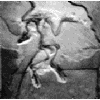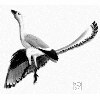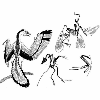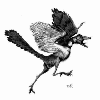Archaeopteryx
CLASSIFICATION
| Archaeopteryx von Meyer, 1861 sensu Nopcsa, 1927 [nomen conservandum] a.k.a Archäopteryx, Archaeopterix, Archeopteryx, ArchopteryxTYPE SPECIES: A. lithographica von Meyer, 1861 sensu Nopcsa, 1927 [nomen conservandum] “stone-written ancient wing/feather” OTHER SPECIES: A. bavarica Wellnhofer, 1993 “Bavarian ancient wing/feather” MISASSIGNED SPECIES: A. crassipes (von Meyer, 1857) [nomen oblitum] (originally Pterodactylus) == Archaeopteryx lithographica A. macrura Owen, 1862 [nomen oblitum] “large-tailed ancient wing/feather” == A. lithographica A. oweni Petronievics, 1917 [nomen oblitum] “Sir Richard Owen’s ancient wing/feather” == A. lithographica A. recurva Howgate, 1984 “recurved ancient wing/feather” ?= Archaeopteryx lithographica A. siemensii Dames, 1897 == A. lithographica |
MEASUREMENTS
TIME
PLACE
REMAINS
ESSAY
| The origin of birds is associated with this creature, the “first bird” (nicknamed “Archie”). Although it resembled other small theropods so much that one skeleton was for years mistakenly identified as Compsognathus, it bore feathers identical to those of modern flying birds. When it was first discovered in 1861, early evolutionists quickly recognized it as the “missing link” between birds and more primitive reptiles. In many ways, Archaeopteryx was unlike modern birds. Like non-avian dinosaurs, it had a bony tail (short for a theropod, very long for a bird), teeth, and clawed fingers. It also had a hyperextendable “switchblade” claw on each foot, like its relatives the dromaeosaurids. But it was a bird and featured avian characteristics, like a reduced number of tail vertebrae and unserrated teeth. Here is a table of known Archaeopteryx specimens (which are named after where they were first displayed): Specimen Found Recognized Complete (feather) 1860 London 1861 Berlin 1876 X Maxberg 1956 Haarlem 1855 1970 Eichstätt 1951 1970 X Solnhofen 1987 X A. bavarica 1992 1993 X The Solnhofen specimen may represent a new genus and species, Wellnhoferia grandis. |

